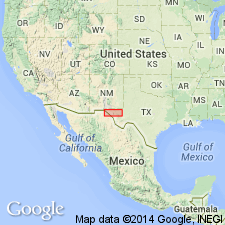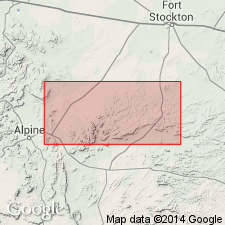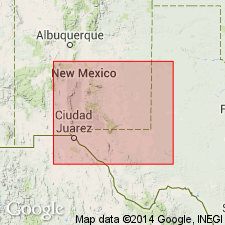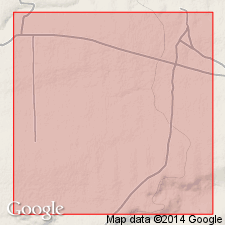
- Usage in publication:
-
- Castile gypsum
- Modifications:
-
- Original reference
- Dominant lithology:
-
- Gypsum
- Limestone
- AAPG geologic province:
-
- Permian basin
Summary:
Pg. 43, geol. map. Castile gypsum. Massive white granular gypsum, in places of grayish or dark color, in other places stained red by iron oxide. Some thin beds of limestone. Thickness 50 to more than 300 feet. Underlies Rustler formation, and believed to unconformably overlie Capitan limestone, but may be contemporaneous with part of Capitan. [Age is Permian.]
Named from Castile Spring [no longer exists] which is in midst of the gypsum, 12 mi south of the NM-TX line in El Paso Co. [now in Culberson Co.], western TX.
Source: US geologic names lexicon (USGS Bull. 896, p. 364).

- Usage in publication:
-
- Castile gypsum*
- Modifications:
-
- Age modified
- AAPG geologic province:
-
- Permian basin
Summary:
Pg. 13. Southeast of reef escarpment [of Capitan limestone] of Guadalupe Mountains the Frijole limestone is overlain by Castile gypsum and Rustler limestone. At one time these were believed to be laterally = Capitan limestone. The revised interpretation of Frijole limestone (that is = top part of Capitan limestone) now makes it clear that these 2 formations are younger than the Capitan, as originally announced by Darton and Reeside (GSA Bull., v. 37, p. 420, 1926) and later by Crandall and others.
Source: US geologic names lexicon (USGS Bull. 896, p. 364).

- Usage in publication:
-
- Castile gypsum*
- Modifications:
-
- Overview
- AAPG geologic province:
-
- Permian basin
Summary:
In Delaware basin of southeastern New Mexico and western Texas there occurs between Rustler limestone and Castile gypsum of Richardson, an unexposed series of salt beds (1,400 feet thick in well borings) known as "upper salt series," in contradistinction to "lower salt series" or Castile anhydrite. To these unexposed rocks W.B. Lang in 1935 (AAPG Bull., v. 19, no. 2) applied the name Salado halite. Neither the Castile nor the Rustler formation is restricted by the introduction of the name Salado, because in all surface exposures the Rustler rests upon the Castile. (See under Salado halite.)
Source: US geologic names lexicon (USGS Bull. 896, p. 364).

- Usage in publication:
-
- Castile anhydrite*
- Modifications:
-
- Revised
- AAPG geologic province:
-
- Permian basin
Summary:
Discriminated Castile anhydrite much farther north in Pecos Valley, where it is overlain by Salado halite and rests on Chalk Bluff formation (new name). Age is Permian.
Source: US geologic names lexicon (USGS Bull. 896, p. 364).

- Usage in publication:
-
- Castile gypsum*
- Castile anhydrite*
- Castile formation*
- Modifications:
-
- Overview
- AAPG geologic province:
-
- Permian basin
Summary:
The following are adopted (ca. 1936) by the USGS: Castile gypsum (in some areas), Castile anhydrite (in Delaware basin), Castile formation (in New Mexico). Age is Permian.
Recognized in western Texas and southeastern New Nexico (Pecos Valley).
Source: US geologic names lexicon (USGS Bull. 896, p. 364).

- Usage in publication:
-
- Castile Formation*
- Modifications:
-
- Revised
- AAPG geologic province:
-
- Permian basin
Summary:
Castile Formation. In subsurface along western edge of Delaware basin, near New Mexico-Texas line, consists of predominantly interlaminated light-gray anhydrite and light-brown, organic-rich calcite. Upper part is "breccia zone," light-gray, massive brecciated anhydrite, approximately 154 feet thick. (The Fletcher Anhydrite Member of Lang, 1942, not recognized in core studied.) Underlies Salado Formation; contact placed at first appearance of magnesite and last appearance of laminated anhydrite typical of the Castile. Overlies Lamar Limestone Member of Bell Canyon Formation. Age is Late Permian (Ochoan).
Core studied: Phillips Petroleum Company corehole (NM 3170-1), in SW/4 SW/4 sec. 21, T. 26 S., R. 25 E., along western edge of Delaware basin, Eddy Co., southeastern NM.
Source: Publication.
For more information, please contact Nancy Stamm, Geologic Names Committee Secretary.
Asterisk (*) indicates published by U.S. Geological Survey authors.
"No current usage" (†) implies that a name has been abandoned or has fallen into disuse. Former usage and, if known, replacement name given in parentheses ( ).
Slash (/) indicates name conflicts with nomenclatural guidelines (CSN, 1933; ACSN, 1961, 1970; NACSN, 1983, 2005, 2021). May be explained within brackets ([ ]).

